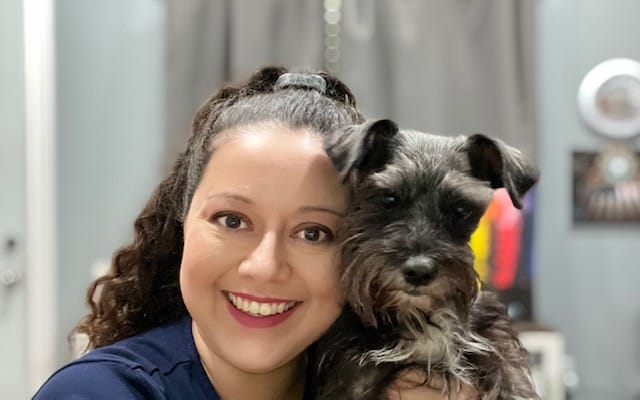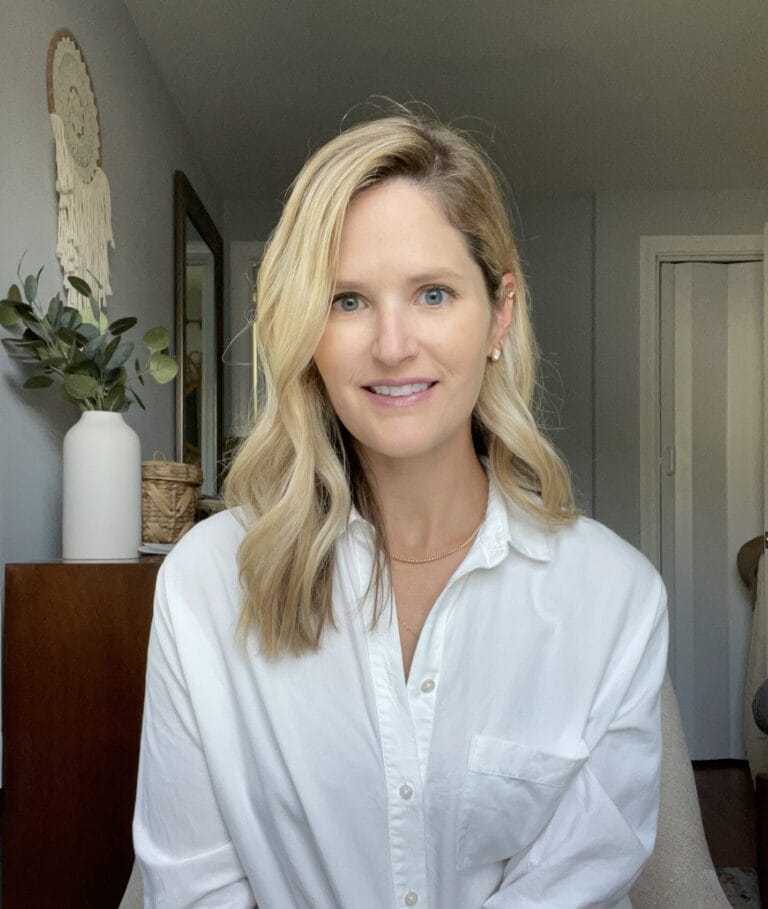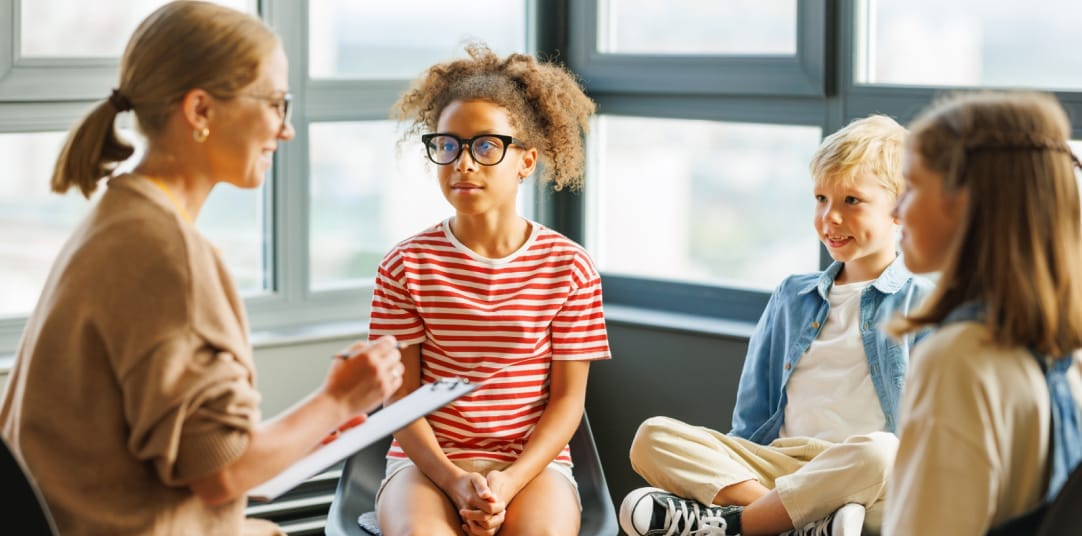

Introduction
I was born and raised in the Rio Grande Valley in Texas, I went to school at what was then named University of Texas—Pan American, or UT Pan Am. Now it is called the University of Texas Rio Grande Valley. I got my bachelor’s in psychology there and my Master’s in school psychology there as well. I have been married for 16 years and we have three daughters. My oldest will be 13. My next is 11. And my little one is going to be three.
The Rio Grande Valley is actually the southernmost part of Texas. A lot of people say South Texas, but they think of San Antonio—we’re 400 miles south of San Antonio. So we’re way at the bottom of the state, close to South Padre Island which is about an hour and a half drive. That’s where I like to go when we have some time. I could probably go every weekend, but we try to go there at least two or three times a year. I love the beach. I’ve said that when I retire, and my daughters are all grown, I’m going to move to the beach. I love spending time there, just being out in the water.
What inspired you to become a school psychologist?
That’s actually the weirdest thing. Because initially, when I first started going to school, I said I was going to be an occupational therapist. So I was already taking some of the prerequisites to become an OT. I met with one of the professors, and I just said “You know, it’s not for me.” During that time, I was taking an Introduction to Psychology class while getting my bachelor’s, and then I took an Abnormal Psychology class, and I absolutely loved it. I switched my major then and went into psychology.
I knew that I wanted to work with kids. I decided I wanted to do something that’s psychology related, but working with children. Then, while I was going to school, I decided to find a job. So I worked at one of our mental hospitals here as a records clerk. From there, I found a job as a secretary at a psychologist’s office. And he is the one that told me that there are positions as a school psychologist—that there is such a thing. I assumed he meant clinical psychologist and he said, “No, if you want to work with kids, you’re going to find a lot more opportunities as a school psychologist.” So I found my way—I didn’t realize that the university even had that program—and started taking classes there.
I had always said that I never wanted to be a teacher. I never wanted to work in education. So this is very strange that I would even go this route. One of my professors in my master’s degree program had said, “It would be good for you to be a teacher—get your alternative certification, become a teacher for a few years, just so you can have that teaching experience.” So I did that. I was a special education teacher for two years while I was getting my master’s. And it was the most amazing thing because what I was learning in school, I was applying to my job, and when I had questions at my job, I would come and bring it to the school setting. So it was very nice. And I think now it’s helped when I work with teachers. I can say I have that teaching background. I have been in the classroom before and I understand what they’re going through as far as all the stresses.
What made you want to be a teletherapist with PL?
I wanted more flexibility in my role as a school psychologist (or LSSP in Texas). I wanted to be able to set my own days and hours to work so that I could spend more time with my daughters.
I think I was just searching on the internet—some random topics like work from home and school psychologists. I ended up finding PresenceLearning and I really liked the company so I decided to give it a try and apply. That’s how I got there.
Could you walk us through your daily routine? A “day in the life of a PL therapist” if you will?
I typically start my days at 9:00 am CT. I choose to do this because the hours prior to this are reserved for the chaos of getting my daughters up and ready for their school day. If I have to test a student, we usually begin at 9:00 or 9:30 and work until lunch time (depending on when the student has lunch, it could be at 11:00 or 12:00). This is also perfect for me because my daughters are home doing virtual learning right now so I can use this break to get their lunches as well. If I need to continue testing after lunch, we do so after 1:00 and work until we are done, which could be anywhere between 2:00 and 4:00 pm. I try to stop what I’m doing at 4:00 so that I can be there for my family (which is the main reason I love the teletherapy setting). Currently, I have 4 students that I see for counseling (last year I had anywhere from 14 to 20). I typically try to keep a day (or two) dedicated to my counseling but at this point, the four students that I have are scattered throughout the week, so the sessions only take up 30 minutes of my day. When I’m not doing counseling, I’m usually either testing, scoring reports, writing reports, interviewing parents via phone calls, or attending IEP meetings. A lot of the schools have gotten behind on their assessments during the pandemic so I am concentrating on doing assessments right now.
I suspect that next school year, there’s going to be a real big need for counseling. Everyday I hear something in the news about the rise of mental health issues in children due to the COVID-19 pandemic. Not only did students lose out in learning but they lost out on gaining social and emotional skills which is actually a valuable aspect in education. Many may believe that education is only about learning academic skills but in fact students who attend school (or who are around their peers on a weekly basis) also gain so much learning experience in social skills and empathy. Even children who were homeschooled before the pandemic experienced some sort of loss in social/emotional skills because their parents were unable to take them to playdates or community events and programs. I hope that school districts are prepared for the emotional adjustment period that is to be expected when the students return to campus full-time. Many children may be anxious to be around others again or may feel disconnected from their peers because they haven’t talked to them in a long time. In any case the emotional conflict they might have may take up a lot of mental space during the school day. School staff need to be prepared to handle this transition and understand that academic skills cannot be gained or recovered if the students are not mentally or emotionally prepared to learn. I’ve always stated that children need to be balanced in their social, emotional, and behavioral skills before they can settle down to learn any academic skills.
In school psychology, a perfect calendar with set days and times is really not heard of. In fact, I could block out an entire day to test a student and the student could end up not showing up due to technical issues, illness, or just forgetting. When that happens I have to rearrange my schedule. Of course I still have plenty of things I can do so it is not a huge issue for me when this happens. The same thing could happen with my counseling sessions. With school psychology, you have to be extremely flexible, so being able to work with PL is perfect because of the flexibility that is provided. I can choose when and how to work.
Do you have any particular practices for self care during your day?
As I described, I try to start my PL day, at 830 or nine. I get my girls ready for school by eight. That gives me a 30 minute window to just eat breakfast and have my coffee—my coffee is self care. Coffee is a must. And because I have an iWatch, it’ll make me get up every 50 minutes. Even if I’m doing an assessment with a student, when 50 minutes have gone by, I’ll say “Let’s take a break. Do you need a break? Let me go get water. I’ll be back.” The students love the online assessment. We could sit there for two, three hours. And I’ve had kids say, “Oh, that’s it? We’re done?” And I’ll respond “You’ve been with me for three hours!” Some want to keep going. I have to tell them, “No, we’re done.” So during the assessment, I have to tell them “Okay, let’s take a break.” Even if they don’t stand up, I model it for them. I’ll stand up. Or I’ll say, “I’m going to get water.” And I drink my water and help make them feel comfortable so that they also realize they need to take a break.
What age range/student population are you currently serving? Please include demographic information.
I am serving K to 12 for assessments. For my counseling students, they are middle school, and high school students.
What do you enjoy about being a provider with PL?
I enjoy the flexibility as well as the support from everyone. From the clinical account managers (CAMs) to tech support, I have always been able to get the help I need when I need it. Everyone is respectful and I feel a sense of family even if we’ve never met in person.
I’ll check the Lounge every now and then. I’ve built the relationship with the CAMs, as well as the school districts. I’ve had one school district that I was with last year and still beginning this year—they’re at the point where they just call me and say, “Hey, this is happening,” and we send text messages. So even though we’ve never met in person, we’re also just very friendly and when we have a meeting we’ll just pick back up as if we saw each other face to face yesterday. So yeah, that’s really nice.
What were you most surprised about when you made the transition to be a teletherapist?
I was surprised with the availability of online assessments. I had no idea cognitive and achievement testing could be administered online. It’s also great to see new assessments being added.
What challenges have you encountered during the transition to teletherapy, and how have you worked to overcome them?
Getting used to the online world was a little challenging because of the technical issues involved when starting. But the tutorials and help center are great for getting answers. I also like that I can get tech support to help me when I’m in the PL room for those times when I have no idea why the video or audio are not working.
When I started out, it would be just very simple things, which now I’m good at. But in the beginning, I’d be starting that assessment and the student’s camera wasn’t working, or they couldn’t get the microphone on, or they couldn’t get the document camera to work. Even though we do have someone there helping the students if they’re at the campus, it was harder when the student was at home, especially with the pandemic, trying to get the parents to figure out the cameras. But with tech support helping me a few times, I learned what to do and how to help them. So I would tell them, “Click on this button, see if it starts up, sign out, and then come back in,” and if that didn’t work that I’d call tech support. I think that was the main issue.
Also, just figuring out what the assessments were initially took a little time because I was so used to using assessment easels in person. When you were in person using easels and now you’re going into the online world and doing an assessment, you’re just clicking over here on the computer which was different but pretty easy to kind of get used to once you do a few assessments.
How has the PL online platform enabled you to help your students and the schools you serve in new ways?
I think the students absolutely love the online platform. They are much more engaged in testing and counseling. They enjoy the stickers and animations, activities, and they even want to keep testing even when I offer breaks. Some have told me they didn’t realize how long they were with me (for testing) because it seemed to go by quickly. That’s always a plus for me because I don’t want them to be bored. The students are also probably much more tech savvy than the adults.
The schools I serve always seem to be very appreciative of the support that PL has, especially when the district is in a rural area. With me personally, the districts that I do assessments for need me for the bilingual evaluations. Many times they do not have anyone locally who can administer a bilingual assessment. If I can complete a full assessment or just the Spanish part of the testing for them, they appreciate that very much. I’m glad I can help them in doing that as well as in interpreting test results to the Spanish-speaking parents during meetings, and conducting a full parent interview in Spanish. This helps from losing any important information when schools have to use a translator.
Can you tell us a little about how you collaborate with teachers and other school staff members?
Email is usually my first line of communication with school staff and teachers. If a teacher doesn’t respond to my email I also email the primary support person (PSP) or special education director (usually the clinical contact). The site contacts also have my phone number so they will text or call me if they have a question they need immediate answers too.
How do you build trust and rapport with parents?
I like to call parents and introduce myself so they know who their child will be working with whether for counseling or assessments. I also email them so they have my email address and phone number and let them know they can contact me for any questions. I typically respond to them right away unless it’s after hours and I’m with my family.
But they’ve all been really, really supportive. You know, they wait for me to call them back, so I can give them test results before their meetings. They’re very appreciative of me helping them out a lot of times. Sometimes they were struggling a lot with their child being at school and now that they’re at home, they see a lot more struggles and they see that the child is really falling behind. So they appreciate the help that we’re providing for them and getting those assessments done. And the same is true for the counseling. For the students I have for counseling right now I text the parents reminders, if they didn’t log in, or, I’ll ask, “Hey, what happened?” And they’ll usually respond, “Oh, we were at an appointment,” or something similar. They’re really good about texting me—I have no problem with parents just texting me back if they have any questions.
What tips do you have for other providers getting started with telepractice?
I think they should just take the plunge. A lot of them are scared. I guess they fear the virtual part of it. I was the same way. I felt, “Oh, this is going to be weird. I have never done this. How do you get the rapport with the student if they’re not right in front of you?” And honestly, everybody has told me that the students love the online assessments versus the actual in-house assessments. I give them virtual high fives and there are all the platform surprises and things that you can put in there—they love it. So I think providers don’t need to be scared of the virtual world. I think this is going to be something that’s going to be even more needed now, after this pandemic. Schools are probably going to jump on it a lot more because of the counseling needs and the assessments. So I think overall, it’s a great place to be if you want that flexibility with your job.
What advice would you give districts considering online therapy?
I highly recommend that districts use online therapy. If districts need help completing assessments, especially bilingual assessments, PL has providers that can do that. Also, I’ve seen a huge need for counseling support, especially now with COVID-19 and students having to stay home. Districts should consider using PL for counseling, if anything, so they can offer those additional supports that students need. Social-emotional well being is very much needed right now and I feel that PL has all the right tools and providers to provide that support.
Are you interested in joining the PresenceLearning Care Network? Click here to start your application.




